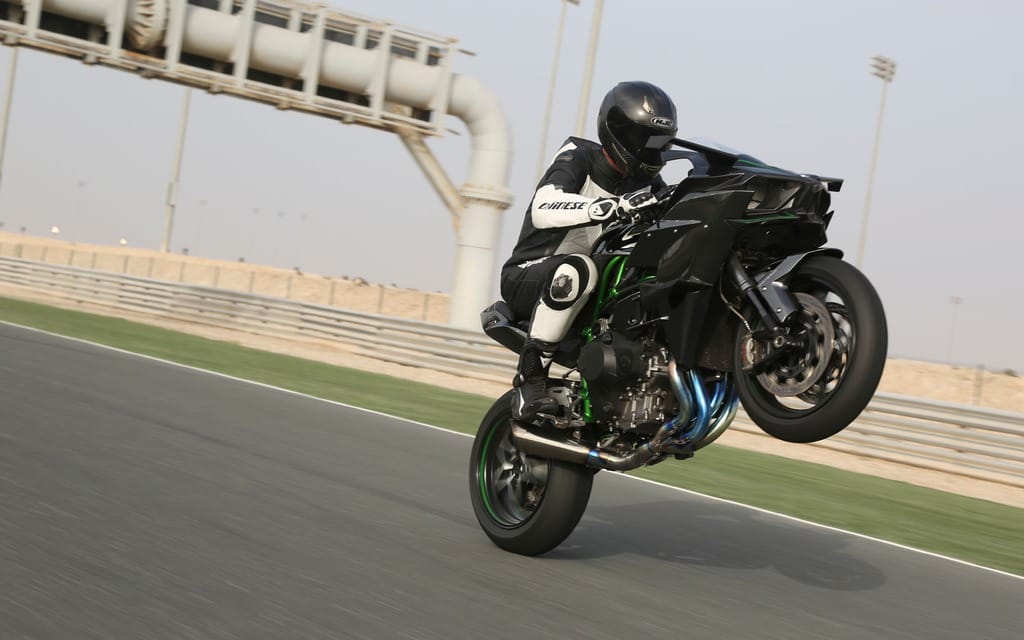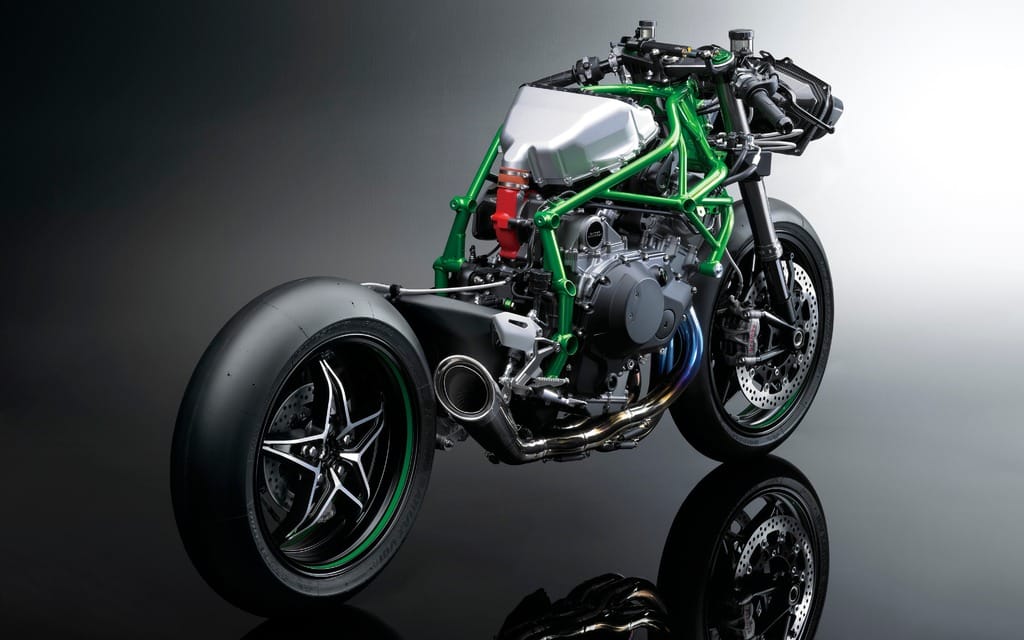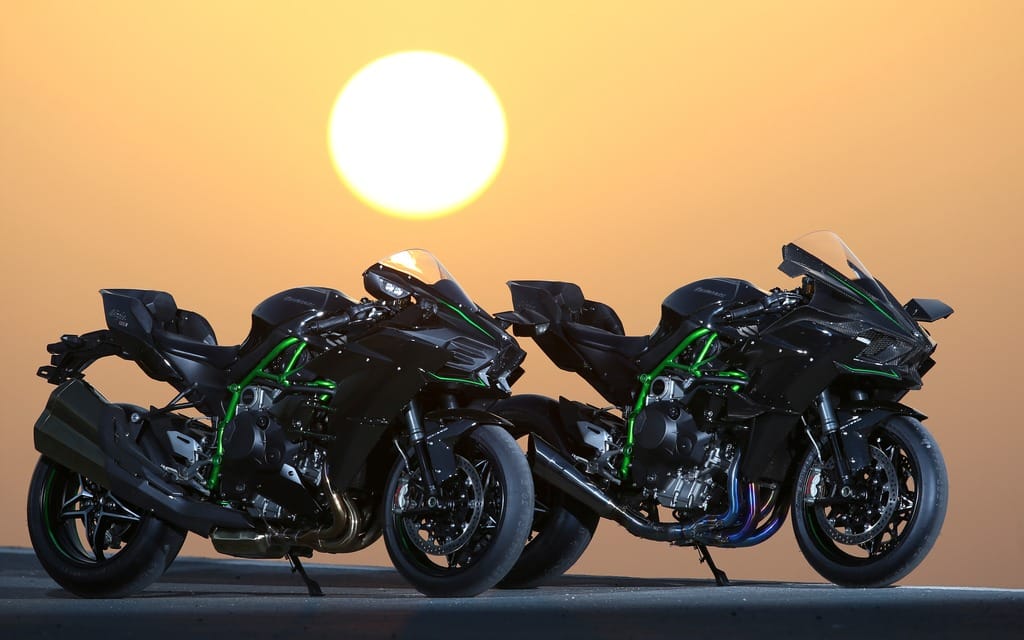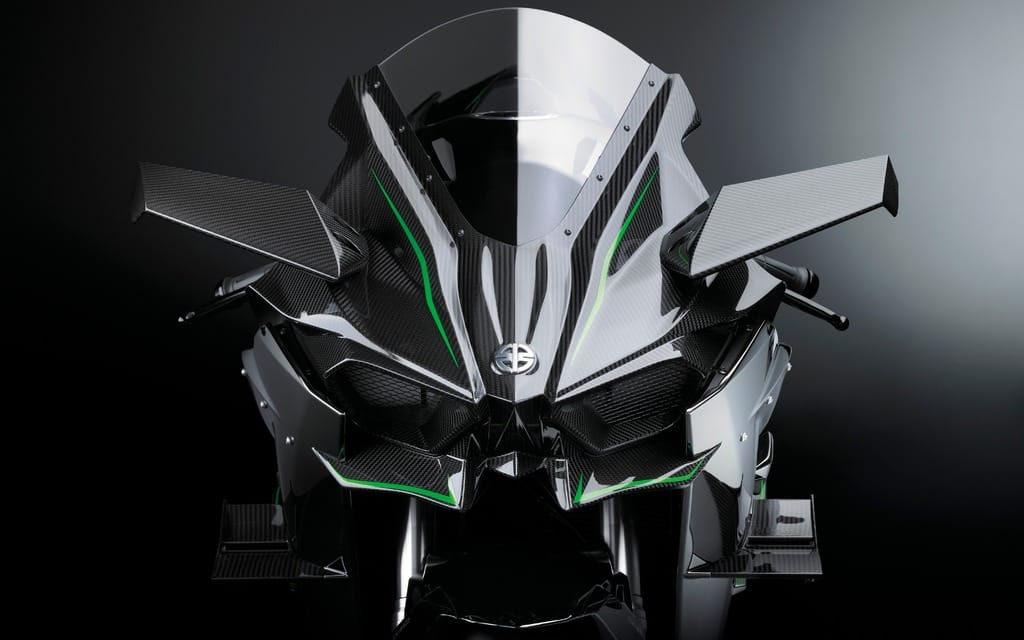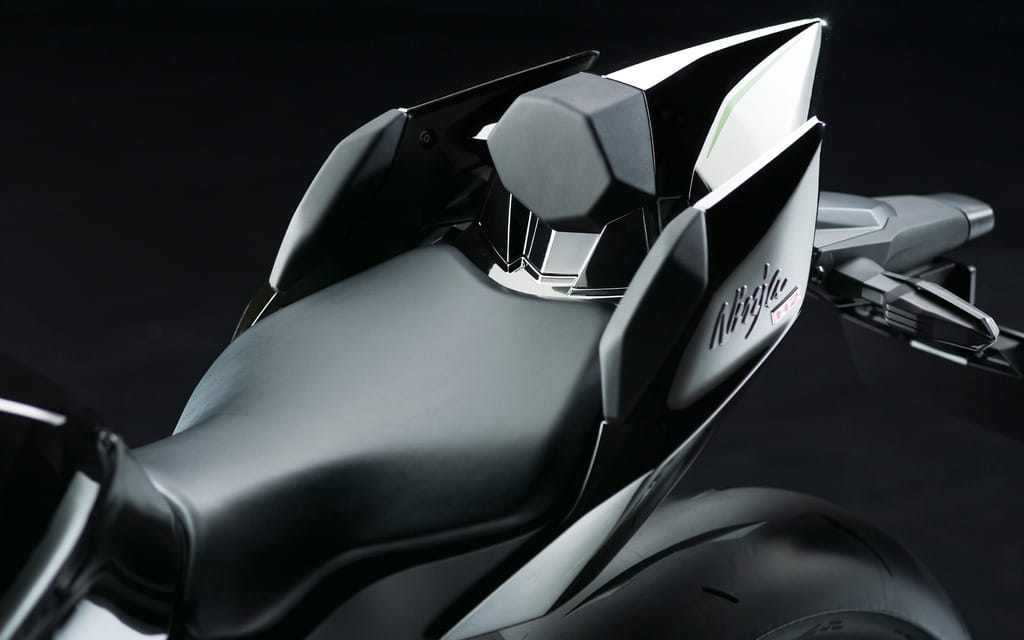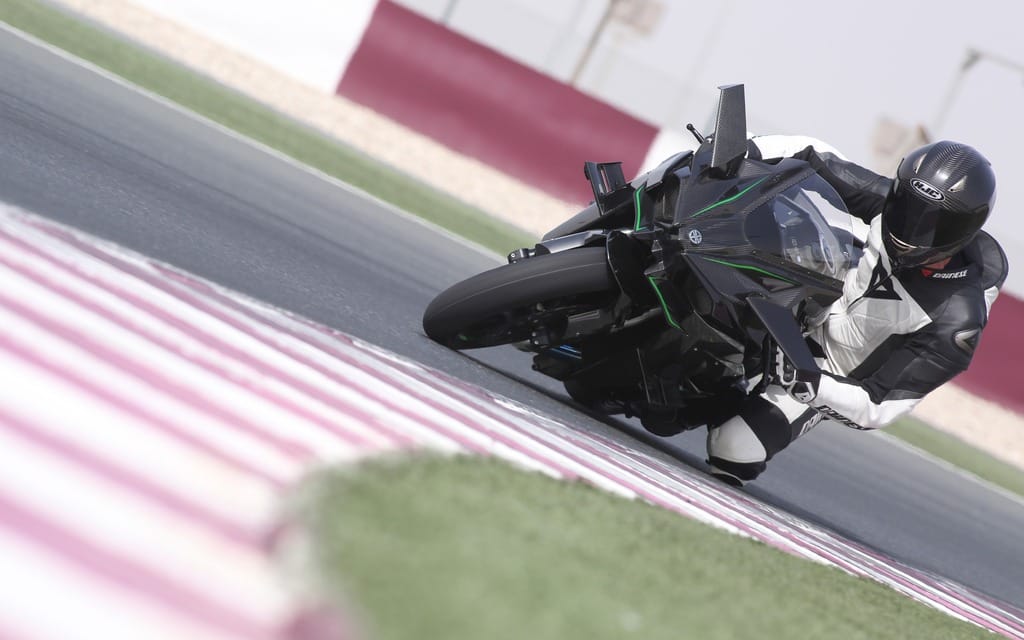Under pressure
Nobody could claim they hadn’t been warned about the Ninja H2 and H2R. There were all those trailer videos last year, followed by huge coverage when the supercharged fours were displayed at the shows, with talk of massive power outputs. Then Kawasaki had said that the original power estimates were too low, and the street-legal H2 actually makes more than 200 horsepower with ram-air, far exceeded by the track-only H2R’s unprecedented output of over 300 horsepower.
But even after all that hype and expectation, it’s shocking to wind back the Ninja H2R’s throttle out of the Losail circuit’s final turn and onto the pit straight. There’s a maniacal shriek as the clip-ons go light in third gear, then the sound rises and falls rapidly as I tuck behind the screen, hold on tight and tap the quick-shifter three more times in quick succession. This incredible bike keeps on pulling hard deep into top before, with the first turn rapidly approaching, I have to sit up and squeeze the front brake lever and brace myself against the braking force and sudden rush of wind on my head and shoulders. It’s a thrilling, violent experience from a production bike whose like has not been seen before.
Back in the pits, a mechanic presses a button on the dashboard to reveal that the H2R recorded a maximum of 319 km/h. A couple of braver (or lighter) hacks went even faster, over 200 mph or 322 km/h. (With taller gearing, a Kawasaki test rider clocked over 357 km/h on a Japanese speed-bowl.) And the standard Ninja H2 had been seriously rapid on the straight in the previous session, revving high in top gear to get close to its electronically limited maximum of 300 km/h.
If you’re looking for speed and excitement, you’ve come to the right place. Kawasaki has long prided itself as a brand that delivers high performance, dating right back to the original H2 two-stroke triple of 1972. And it’s absolutely no coincidence that the firm revived the H2 name for this pair of supercharged bikes that are the most outrageous and hardest accelerating yet from a major manufacturer.
That first H2, also known as the Mach IV, earned a reputation as the world’s quickest streetbike, and also as a wild machine that spat off plenty of riders. It was the basis of the even more fearsome H2R factory triple that won races in the hands of stars including Paul Smart and Yvon DuHamel, but earned the nickname “Green Meanie” with some vicious behaviour at speed.
That was the spirit that forged Kawasaki’s reputation, and which the firm wanted to recreate with the modern Ninja H2 and H2R. They certainly made a good start with the styling, which is stunning — an array of dramatic, distinctive shapes with a quality of finish rarely seen on a production bike. The H2R is unusual in that its carbon fibre half-fairing is equipped with pairs of aerodynamic fins on either side, shaped to provide down force at high speed.
The H2 doesn’t have those but the Aerospace division carefully shaped its mirrors. And the standard model’s plastic bodywork has mirror-like paintwork that contains genuine silver and is applied by hand. The road-going Ninja also has a host of other neat details, from its LED lights and neatly machined top yoke to the sculpted tailpiece.
Of course the engine, almost all of which is common to both models, is special too: a 998 cc, 16-valve inline four-cylinder similar to that of the ZX-10R, but created to be boosted by a supercharger, which was also purpose-designed and produced in-house.
Even the chassis is like nothing Kawasaki has ever built before, based on a tubular steel trellis frame that would be Ducati-like if it wasn’t painted metal-flake green instead of red, and didn’t employ a four-cylinder engine as a stress-bearing member to locate the single-sided aluminum swing-arm. Both bikes have KYB suspension front and rear, with the 43 mm fork adjusters set into the green tops that poke through the immaculately machined top yoke.
The standard H2’s claimed maximum output of 197 hp at 11,000 rpm (without ram-air) puts it on par with the latest crop of super-sport bikes, but its torque output far exceeds that of conventional engines, and the Ninjas aren’t intended to be pure sport bikes. Their riding position is more relaxed than the ZX-10R’s, with clip-ons 10 mm higher and wider, footrests farther forward by 10 mm, and a more roomy and generously padded seat, which has 15 mm of fore-and-aft adjustability and is shaped to give support under hard acceleration.
Any suggestion that the H2 is a slightly more comfy sportbike disappears the moment you open its throttle in the lower gears. The response is sudden, to say the least, as the supercharger kicks in to send the bike lurching forward with an abruptness that makes fine control difficult. Aiming the H2 around the Losail circuit for the first few laps, my mind flashed back to the morning’s press conference and the phrase “demands the razor-sharp reactions of an experienced rider.” The words were written about the original 750 cc H2 two-stroke triple of 1972 but ring true of its descendant.
The Ninja is as demanding as it’s powerful. And one thing’s for sure: this thrilling supercharged brute demands maximum concentration. I was wary of opening the throttle at the apex of turns (a fast and experienced rider had high-sided himself into hospital the day before) and found the best solution was to finish braking slightly early, then dial in a little throttle and boost before the apex of a turn so the bike was steady at full lean and able to accelerate more smoothly.
As the boost built (not that I could tell from the small, hard-to-read gauge) and the bike tore forward, it was difficult to be sure exactly what the traction control was doing, except that it usefully kept the front wheel near the ground as the Ninja catapulted down the straightaway. Its monstrous midrange power delivery let it rev even quicker than normally aspirated bikes, its quick-shifter (which worked flawlessly, but only on up-shifts) helped feed it gears, and its respectably tall screen enabled me to keep my head out of the wind-blast. The standard exhaust’s muted sound was soon lost to the wind, but the supercharger compensated with a twittering sound on a closed throttle.
With a claimed weight of 238 kg the H2 is notably heavier than a traditional litre-bike, but it handled very well. Kawasaki says it chose the trellis frame partly to aid cooling but mainly because it allows a little flex that aids stability at very high speeds. The bike lived up to that promise, keeping rock solid in a straight line and composed in bends, especially after the mechanics had firmed both ends slightly. The Öhlins electronic steering damper, which adjusts according to speed and acceleration, doubtlessly also contributed.
The relatively wide clip-ons helped with manoeuvrability, and Bridgestone slicks (which are standard fitment on the H2R; the H2 will come with street-legal Battlax RS10FGs) ensured heaps of grip. There was plenty of braking power, too, with the front blend of 330 mm rotors and Brembo radial calipers biting hard and refusing to fade even when the H2R was repeatedly hauled down from almost 320 km/h, though the ABS cut in earlier than the best rival systems.
These Ninjas aren’t designed to be practical, but the H2 should make a useful roadster, provided you don’t need to carry a pillion. The 17-litre tank capacity means range won’t be huge but the bike is roomy, gives decent wind protection, and has excellent ride quality, helped by a fairly generous 135 mm of rear wheel travel. The classy looking instrument panel includes fuel consumption and lap time info. Mirrors are wide and clear — at least until blue flashing lights appear in them.
Even so, by most objective criteria neither Ninja makes a lot of sense. They’re more difficult to ride than most conventional superbikes, have fewer safety aids and would be slower around a racetrack. The H2R can’t be ridden on the road, and will need quietening before it can even be used on any sound-sensitive track day.
And of course their prices are high. The H2 is more expensive than any of the hugely capable sport bikes from rival firms, and the R-model costs almost twice as much as that. But how can you put a value on that supercharged stomp, or the thrill of the blown four’s shriek? Nothing else comes even close. Added to which, both models’ rarity should ensure that resale values remain high.
Kawasaki built a pair of bikes that “showcase the best of our company, that are different to anything ever built both technically and visually, and are as exciting as the legendary machines that made us famous more than 40 years ago.”
The dirty bits
The 998 cc, 16-valve engine is all new, not a revamped ZX-10R unit, despite the obvious similarities and identical bore-and-stroke dimensions of 76 x 55 mm. Supercharged engines generate a lot of heat and inflict huge demands on parts such as bearings, so the H2 lump was designed to put up with twice as much stress as a normally aspirated engine. Pistons are cast, rather than forged, to cope better with very high temperatures, and have flat tops to reduce compression from the ZX-10R’s 13:1 to under 9:1.
The supercharger was designed specifically for this application by Kawasaki. It turns at 9.2 times the speed of the crankshaft, so at the H2R’s maximum of 14,000 rpm it’s spinning at roughly 130,000 rpm. It’s located behind the cylinders, generates 2.4 times atmospheric pressure, and feeds a rigid aluminum airbox.
To withstand the extreme heat of supercharged combustion, the exhaust valves are made from two materials, Inconel and steel, that are friction-welded together at their centres. The two engines are similar, the only differences being the camshafts, head gaskets, and clutch. But their outputs are very different: the standard H2 claims 197 hp at 11,000 rpm (207 hp with the ram-air effect at speed) and the H2R claims a staggering 319 hp with ram air. Kawasaki insists that the H2 can’t be converted to H2R specification, though people will most certainly try.
The chassis is unlike anything that Kawasaki has built before, especially for a four-cylinder engine. The steel tubes are of differing dimensions, laser-cut to ensure accuracy, partially hand-welded and finished in metal-flake Kawasaki green. Kawasaki says the frame design was chosen, instead of the familiar aluminum beam layout, because it allows a little flex, which improves stability at very high speed. The layout also allows engine heat to escape and gives room for the H2’s single air duct from the fairing nose, and the H2R’s similar carbon-fibre duct on each side.
The rear subframe is aluminum, as is the single-sided swingarm, shaped to allow room on the right side for the exhaust’s silencer — which in the case of the standard H2 is a large and ugly device that some importers are replacing with a more attractive and undoubtedly more tuneful Akrapovic can.
Project leader Satoaki Ichi on what it’s all about
“We heard a lot of customers, and also people inside Kawasaki, saying that nowadays motorcycle performance is getting better and better, the bikes are easier to control, but there is something missing — and that’s the excitement of riding. At Kawasaki our core brand is performance and excitement, so we felt a strong need to develop something very special to satisfy those customers’ feelings.
“The H2 project was started a little more than two years ago but we had already investigated supercharger technology, starting seven years ago. We looked not only at performance oriented superchargers but in other directions, like eco- or smaller capacity engines. We have plenty of possibilities and we think that supercharging is one of the key technologies for Kawasaki. Being able to produce the supercharger in-house brings a lot of possibilities, so it’s an important direction for the future.
“For our first bike with a supercharger we wanted to go in a typical Kawasaki direction, performance, so we decided to go with the H2 and H2R concept. We set out to develop both models from the beginning, and the H2R development led the project. The maximum horsepower of a [normally aspirated] bike is around 200 hp so we set the target at around 1.5 times that. We could have gone to 400 hp but then the engine design got much heavier. We wanted to develop an enjoyable bike, so we decided to stop at around 300 hp.
“The H2 is not designed to cut every second on lap time. We wanted an enjoyable, high-performance sports bike. We targeted a customer who is experienced, so the age is relatively high. So we made the seat reasonably thick, and the clip-on position a little bit more upright to give a more comfortable riding position.
“The main reason for using a trellis frame was stability. A ZX-10R-type twin-spar frame is too rigid if you have 300 hp. The bike gets too nervous, so only professional riders can handle it. That’s why we decided to use something a little more flexible: to absorb the external noise. With steel you can enjoy 300 hp!
“In the future we might use the trellis layout for other engines, because through the H2 development we learned a lot about the capabilities of this type of frame. That gives us a chance to use one again. Maybe it won’t be completely the same type of frame but there will be things we learnt with this project that we can utilise for other bikes.”
